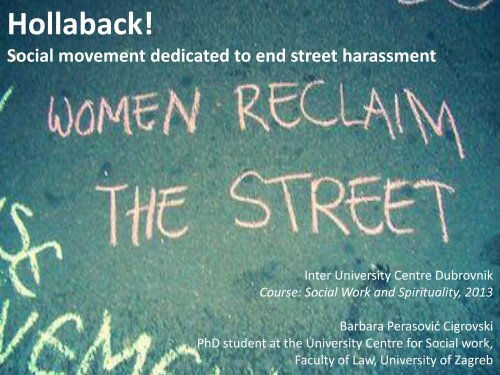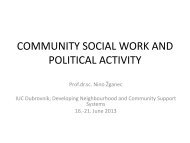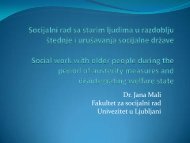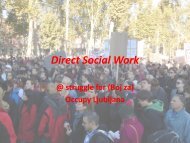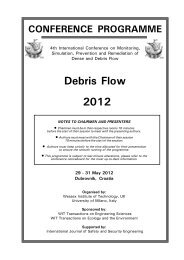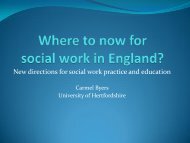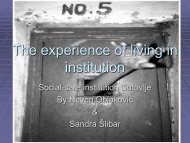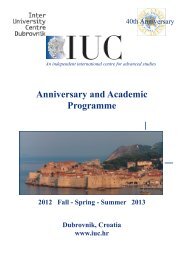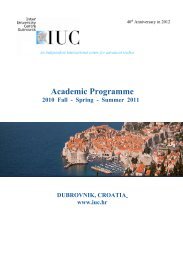Barbara Perasović - Hollaback Social movement - IUC
Barbara Perasović - Hollaback Social movement - IUC
Barbara Perasović - Hollaback Social movement - IUC
You also want an ePaper? Increase the reach of your titles
YUMPU automatically turns print PDFs into web optimized ePapers that Google loves.
<strong>Hollaback</strong>!<br />
<strong>Social</strong> <strong>movement</strong> dedicated to end street harassment<br />
Inter University Centre Dubrovnik<br />
Course: <strong>Social</strong> Work and Spirituality, 2013<br />
<strong>Barbara</strong> <strong>Perasović</strong> Cigrovski<br />
PhD student at the University Centre for <strong>Social</strong> work,<br />
Faculty of Law, University of Zagreb
Introduction<br />
My perspective:<br />
• <strong>Hollaback</strong> activist from 2011<br />
• PhD student from 2011/2012<br />
References:<br />
• Literature on social <strong>movement</strong><br />
• Literature on gender based violence<br />
• PhD dissertation (Jill Dimond, 2012): “Feminist HCI for real: designing<br />
technology in support of a social <strong>movement</strong>”
<strong>Hollaback</strong>: Contents<br />
<strong>Social</strong> <strong>movement</strong> dedicated to end street harassment<br />
1. About street harassment<br />
2. About <strong>Hollaback</strong>!<br />
a) History and development<br />
b) Organizational model<br />
c) Activities<br />
3. <strong>Hollaback</strong>’s model as a tool of empowerment<br />
a) Storytelling as a tool of empowerment<br />
b) Empowerment of volunteers
ABOUT STREET HARASSMENT
Definition<br />
Harassment of women and LGBTIQ people taking place in public spaces:<br />
Harassment:<br />
• Broad range of unwanted behaviours (verbal harassment, masturbation at<br />
public places, groping, following, threat of physical violence)<br />
• Point of view of the victim, not the harasser<br />
Form of gender based violence:<br />
• Harassed are mainly women or LBGTIQ persons, harassers are mainly men<br />
• Intersectional (activists); feminist issue (activists and scholars)<br />
Public spaces:<br />
• Streets, parks, public transport<br />
• Harassment at school/work – better legally protected, more researched
Incidence, consequences<br />
Incidence:<br />
• 80 – 100% of women in most studies worldwide<br />
• Online survey by <strong>Hollaback</strong> Croatia (women, N=446):<br />
• Some form of verbal encounter: 70 – 90%<br />
• Public masturbation, groping or being followed: 41 – 55%<br />
• Physical attack: 32%<br />
• One in two women will experience some form of street harassment by the age of 18<br />
Consequences:<br />
1. Individual consequences<br />
• Negative emotions (fear, annoyance/anger, humiliation), fear of rape, triggering previous trauma<br />
• Self – objectification<br />
• Restriction of <strong>movement</strong> in public space<br />
2. Consequences for gender and society<br />
• Discrimination of women: objectification; reinforcement of division of public/private sphere and<br />
hierarchy of sexes; “gateway crime”
ABOUT HOLLABACK!<br />
DEVELOPMENT, HISTORY, MAIN ACTIVITIES
History<br />
2005 – 2009<br />
• Recognition of the issue of street harassment by 5 friends, inspired by a video<br />
portraying an incident of harassment in New York subway<br />
• New York based blog<br />
• Emily May – one of the founders and today’s leader<br />
2009 - present:<br />
• Development of the organizational model and building of a <strong>movement</strong><br />
• Registering as NGO in New York = motherhood<br />
• Since 2011, launch of 5-10 sites every three months<br />
Impact:<br />
• Over 750 press hits, 25 000 Facebook fans and 8 000 Twitter followers<br />
• Today present in 62 cities, 25 countries and 12 different languages
Organizational model<br />
Division of labour in <strong>Hollaback</strong> – partial decentralisation - is reinforced by its digital tools;<br />
At the same time, key activities of the <strong>movement</strong> are enabled via digital tools.<br />
Technology<br />
Collection and mapping of stories<br />
of street harassment<br />
Add-ons for the blog<br />
Centrally based blog with local access<br />
Partial<br />
decentralisation<br />
<strong>Social</strong> networks as a place for connecting<br />
volunteers worldwide<br />
Locally based on the ground activities
Stories and blog<br />
Collection and mapping of stories<br />
of street harassment (No=4500, Jan 2012)<br />
Add-ons for the blog<br />
Centrally based blog with local access
Activities<br />
Internet based activities<br />
• Collection & mapping of stories<br />
• Blog<br />
• <strong>Social</strong> networks<br />
On the ground activities<br />
• Campaigns<br />
• Street art<br />
• Education<br />
• Collaboration with other<br />
similar organizations
<strong>Social</strong> <strong>movement</strong> defined<br />
<strong>Social</strong> <strong>movement</strong>: “Collective challenges by people with common purposes<br />
and solidarity in sustained interactions with elites, opponents, and<br />
authorities” (Tarrow, 2011)<br />
Contentious collective action: “Actions used by people who lack regular<br />
access to representative institutions, who act in the name of new or<br />
unaccepted claims” (Tarrow, 2011)
HOLLABACK’S MODEL<br />
AS A TOOL OF EMPOWERMENT
Storytelling as tool of<br />
empowerment (I)<br />
Key question: What is the role of storytelling in a social <strong>movement</strong> organization?<br />
Framing processes:<br />
• Among key concepts in studies of social <strong>movement</strong>s<br />
• Cognitive concept – frames are “schema of interpretation”<br />
• Interactive – individual frames become linked with collective understandings<br />
• Action oriented sets of beliefs and meanings - inspire and legitimate the activities of<br />
social <strong>movement</strong> organizations<br />
Methodology: Interviews with people who submitted a story to <strong>Hollaback</strong>, N=13
Storytelling as tool of<br />
empowerment (II)<br />
Posting and reading stories...<br />
... changed the way contributors thought and felt about their experience<br />
• Validation of the experience vs. previous trivialization and feeling alone<br />
• Reclaiming power that was lost when they were harassed<br />
• Shifting the blame<br />
... helped them to view their experience as part of a collective phenomenon and as part<br />
of a community<br />
• Feeling part of a group<br />
• Feeling that now others can benefit from their stories<br />
...enabled them to problematize their experiences and connect it to other issues, e.g.<br />
the right to be in a public space or the position of women in the society<br />
●<br />
“Before reading those stories, and posting, I accepted it as the norm to get harassed all the<br />
time. But it's not something that I really thought about as a serious problem. But now, I think it<br />
definitely portrays how people think about women..."
Empowerment of<br />
volunteers (I)<br />
Key question(s): Can <strong>Hollaback</strong>’s decentralised model, and digital activism in<br />
particular, attract and empower activists worldwide?<br />
• Activism as hobby activity vs. full time identity / specialized profession<br />
• Activism for historically marginalized people who might not have access to it<br />
Methodology:<br />
● Semi structured interviews with 13 site leaders<br />
● Case studies of three sites<br />
● Observation, researcher participation
Empowerment of<br />
volunteers (II)<br />
Enabling digital activism...<br />
...may help deconstruct the identity of the professional activist and attract new activists<br />
who have never engaged with activism before:<br />
“And, why I started one? It was one of these ideas when you say, wow that's it. Because I have a full<br />
time job, that doesn't have a lot to do with activism, in the business sector. And this is something I<br />
can do relatively easily in my free time.”<br />
...may help historically marginalized people to engage with social causes they might not<br />
otherwise have access to:<br />
Site leaders’ statistics:<br />
• 75% are under 30,<br />
• 50% are under 25,<br />
• 44% are LGBTQ and<br />
• 26% are people of colour.
Instead of a conclusion...<br />
Critics / cons<br />
“Revolution will not be tweeted” (Gladwell, 2010.)<br />
Support cannot be given virally<br />
“Invisible friend” (Site leader, Buenos Aires)<br />
Autonomy vs. mothership<br />
Colonialism<br />
Image of North Western/Corporate feminism<br />
Responses to critics / pros<br />
Solidarity and sense of belonging established through<br />
common purpose and social networks<br />
Training for finding and sustaining local volunteers<br />
in order to gain offline support<br />
Main role of the board is to advise and help with<br />
fundraising, not dictating what local branches should<br />
do<br />
Mothership responsive to local culture<br />
Partnering with other, local organizations<br />
Local engagement – more work than anticipated<br />
Decontructing the professional activist<br />
Attracting only volunteers with resources<br />
(knowledge of English, access to PC)<br />
Is story sharing enough?<br />
Empowering local activist’ through education and<br />
support<br />
MAKING STREET HARASSMENT A GLOBAL ISSUE<br />
BY MULTIPLYING VOICES
THANK<br />
YOU!


